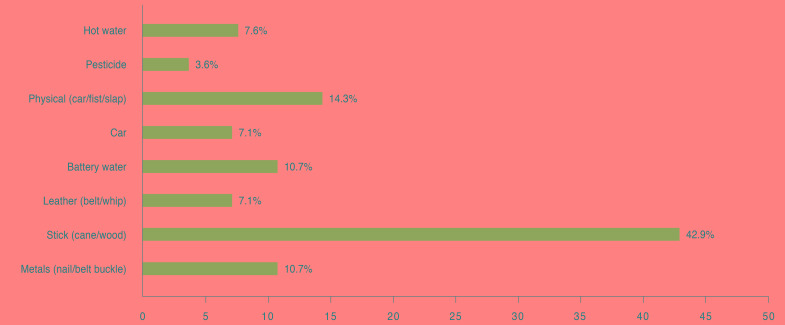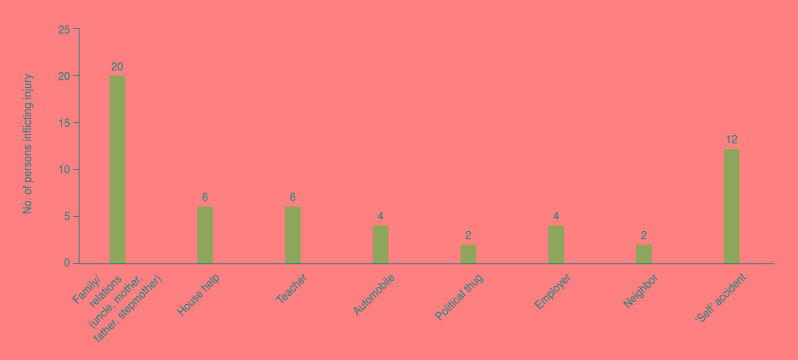Korean J Ophthalmol.
2017 Apr;31(2):143-150. 10.3341/kjo.2017.31.2.143.
Child Abuse and the Eye in an African Population
- Affiliations
-
- 1Department of Surgery, College of Health Sciences, Osun State University, Osogbo, Nigeria. michaeline.isawumi@uniosun.edu.ng
- 2Department of Ophthalmology, LAUTECH Teaching Hospital, Osogbo, Nigeria.
- KMID: 2373471
- DOI: http://doi.org/10.3341/kjo.2017.31.2.143
Abstract
- PURPOSE
There is a paucity of data on child abuse and the eye in West Africa. Therefore, a need exists to determine the causes and circumstances surrounding these occurrences and their effects on the eye and vision in a pediatric population.
METHODS
A 3-year study of consecutive cases of ocular features that presented to an eye clinic following a history suggestive of child abuse along with any associated eye injury was carried out. Socio-demographic characteristics were obtained, as were the presenting and posttreatment visual acuity, and a full clinical eye examination was also done.
RESULTS
Fifty-six children with 56 affected eyes were examined. The male to female ratio was 1.8 : 1; the mean age was 8.25 ± 3.5 years; and the subjects were predominately primary school children 30 (53.6%). The most common ocular disorders were conjunctiva hyperemia (46.4%), corneal abrasion/ulcer (25.4%), hyphema/uveitis (42.9%), retinal detachment (7.1%), sclera rupture (7.1%), and globe perforation (21.4%). The intraocular pressure was raised in 17.9% of participants. Presenting versus posttreatment visual acuities showed normal vision in four (7.1%) vs. eighteen (32.1%), visual impairment in 12 (21.4%) vs. six (10.7%), severe visual impairment in 20 (35.7%) vs. 12 (21.4%), and blindness in 12 (21.4%) vs. 14 (25%), p < 0.001. The most common injurious agents were canes (25.0%) and sticks (17.9%). The people who inflicted the injuries were parents/relatives (uncles) in 35.7% of cases and the children themselves (accidents) in 21.4% of cases. Circumstances predisposing participants to eye injuries were child labor in 39.3% and beatings in 25.0%. Complications were cataracts (25.0%), corneal opacity (39.3%), and retinal detachment (7.1%).
CONCLUSIONS
Injuries commonly resulted from canes and sticks used during beatings, as well as from child labor, corporal punishment, accidents, and assaults. Legislation and laws need to be enacted to prevent negative psychosocial and economic impacts on the child, family and country as a whole.
Keyword
MeSH Terms
Figure
Reference
-
1. Child abuse [Internet]. Wikipedia;2017. cited 2017 Feb 25. Available from: https://en.wikipedia.org/wiki/Child_abuse#Sexual_abuse.2. Child Welfare Information Gateway. Definitions of child abuse and neglect: child welfare [Internet]. Washington, DC: Child Welfare Information Gateway;2015. cited 2015 April 14. Available from https://www.childwelfare.gov/topics/can/defining/.3. Harley RD. Ocular manifestations of child abuse. J Pediatr Ophthalmol Strabismus. 1980; 17:5–13. PMID: 7365649.
Article4. UNICEF. Definition of child labour [Internet]. New York: UNICEF;2015. cited 2015 April 14. Available from: https://www.unicef.org/infobycountry/stats_popup9.html.5. Chana HS, Klauss PV. Ocular manifestations of child abuse. Community Eye Health. 2002; 15:11–12. PMID: 17491895.6. Abolfotouh MA, El-Bourgy MD, Seif El, Mehanna AA. Corporal punishment: mother's disciplinary behavior and child's psychological profile in Alexandria, Egypt. J Forensic Nurs. 2009; 5:5–17. PMID: 19222684.
Article7. Smith DE, Mosby G. Jamaican child-rearing practices: the role of corporal punishment. Adolescence. 2003; 38:369–381. PMID: 14560888.8. Alyahri A, Goodman R. Harsh corporal punishment of Yemeni children: occurrence, type and associations. Child Abuse Negl. 2008; 32:766–773. PMID: 18657859.
Article9. Alemika EE, Chukwuma I, Lafratta D, editors. Rights of the child in Nigeria: report on the implementation of the convention on the rights of the child by Nigeria. Geneva: Committee on the Rights of the Child;2005. p. 4–22.10. Nwomeh BC, Ameh EA. Pediatric trauma in Africa. Afr J Trauma. 2003; 1:7–13.11. Ayanniyi AA, Mahmoud OA, Olatunji FO, Ayanniyi RO. Pattern of ocular trauma among primary school pupils in Ilorin, Nigeria. Afr J Med Med Sci. 2009; 38:193–196. PMID: 20175424.12. Adeoye AO. Eye injuries in the young in Ile-Ife, Nigeria. Niger J Med. 2002; 11:26–29. PMID: 12073297.13. World Health Organization. International statistical classification of diseases and related health problems: ICD-10 version for 2010 [Internet]. Geneva: World Health Organization;2010. cited 2015 Nov 12. Available from: http://apps.who.int/classifications/icd10/browse/2010/en.14. Shumba A. Epidemiology and etiology of reported cases of child physical abuse in Zimbabwean primary schools. Child Abuse Negl. 2001; 25:265–277. PMID: 11330924.
Article15. Oyedeji GA. Socio-economic and cultural background of hospitalized children in Ilesha. Niger J Paediatr. 1985; 12:111–117.16. Skarbek-Borowska SE, Campbell KT. Globe rupture and nonaccidental trauma: two case reports. Pediatr Emerg Care. 2011; 27:544–546. PMID: 21642793.17. The International Children's Anophthalmia Network. Treatment [Internet]. Philadelphia: ICAN;2015. cited 2015 April 30. Available from: http://www.anophthalmia.org/treatment/.18. DeRidder CA, Berkowitz CD, Hicks RA, Laskey AL. Subconjunctival hemorrhages in infants and children: a sign of nonaccidental trauma. Pediatr Emerg Care. 2013; 29:222–226. PMID: 23546430.19. Matschke J, Puschel K, Glatzel M. Ocular pathology in shaken baby syndrome and other forms of infantile non-accidental head injury. Int J Legal Med. 2009; 123:189–197. PMID: 18936952.
Article20. Levine LM. Pediatric ocular trauma and shaken infant syndrome. Pediatr Clin North Am. 2003; 50:137–148. PMID: 12713109.
Article22. Chianu E. Two deaths, one blind eye, one imprisonment: child abuse in the guise of corporal punishment in Nigerian schools. Child Abuse Negl. 2000; 24:1005–1009. PMID: 10905423.
Article23. Mahmoud AO, Ayanniyi AA, Salman MF. Observations of teachers in Ilorin, Nigeria on their practices of corporal punishment that are potentially injurious to their pupils' eyes. Ann Afr Med. 2011; 10:150–154. PMID: 21691023.
- Full Text Links
- Actions
-
Cited
- CITED
-
- Close
- Share
- Similar articles
-
- Child sexual abuse and pediatricians
- Child abuse, can we find child abuse?: Role of the pediatrician
- Child Abuse and Neglect
- The Attitude toward Child Abuse in Korea
- Influencing Factors of Clinical Nurses' Knowledge of Child Abuse Reporting, Perception of Child Abuse, and Moral Sensitivity on the Attitude toward Reporting Child Abuse



